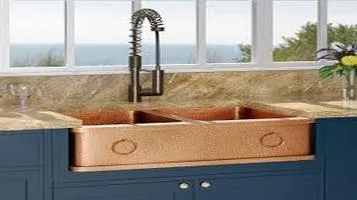Review of Farmhouse Sinks
Farmhouse sinks, also known as apron-front sinks, are a popular choice in kitchen design due to their distinctive blend of style and functionality. These sinks are characterized by their deep basins and exposed front panel, which extends slightly beyond the edge of the surrounding cabinetry. Originally designed for farm kitchens, where large volumes of water were used for cooking and cleaning, farmhouse sinks are appreciated today for their practicality and classic appeal. Typically crafted from materials like fireclay, cast iron, or stainless steel, they offer durability and a variety of aesthetic options to complement different kitchen styles. Their generous size makes them ideal for washing large pots and pans, while their timeless design adds a touch of rustic charm to modern and traditional kitchens alike.

Farmhouse sinks, also known as apron-front sinks, have seen a significant resurgence in popularity over recent years. Originating from rustic farmhouses, these sinks have become a staple in modern kitchen designs due to their blend of functionality and aesthetic appeal. This review delves into the various aspects of farmhouse sinks, examining their benefits, drawbacks, styles, and overall impact on kitchen spaces.
Design and Aesthetic Appeal
One of the most striking features of farmhouse sinks is their design. Unlike traditional undermount or drop-in sinks, farmhouse sinks are characterized by their deep basins and exposed front panel, which extends slightly beyond the edge of the countertop. This design not only makes a bold visual statement but also adds a touch of rustic charm to any kitchen.
The aesthetic versatility of farmhouse sinks is another reason for their popularity. They are available in a variety of materials, including fireclay, cast iron, stainless steel, copper, and even granite composite. Each material brings its own unique texture and finish to the sink, allowing homeowners to choose a style that complements their kitchen decor. For instance, a white fireclay farmhouse sink exudes a classic, timeless elegance, while a hammered copper sink adds a warm, artisanal touch.
Functionality
Beyond their visual appeal, farmhouse sinks are celebrated for their functionality. The deep, wide basins of these sinks provide ample space for washing large pots, pans, and baking sheets, which can be a challenge in standard sinks. This makes them particularly attractive for avid cooks and large families who require a spacious and efficient washing area.
The apron-front design also reduces the need to lean over the counter while washing dishes, which can be a significant ergonomic advantage. This feature can help reduce back strain and make kitchen tasks more comfortable, especially for those who spend a lot of time at the sink.
Durability and Maintenance
The durability of farmhouse sinks largely depends on the material chosen. Fireclay and cast iron sinks are known for their robustness and resistance to chipping and scratching. However, they can be quite heavy and may require additional support during installation. Stainless steel sinks, while not as visually striking, offer excellent resistance to stains and rust, making them a low-maintenance option. Copper sinks, on the other hand, develop a natural patina over time, which some homeowners find appealing, though they may require more frequent cleaning to maintain their appearance.
Maintaining a farmhouse sink is generally straightforward, but it does require some attention to prevent damage. For example, while fireclay is resistant to most stains, it can chip if heavy objects are dropped into it. Similarly, copper sinks can be sensitive to acidic substances, which can affect their finish. Regular cleaning with mild soap and water is typically sufficient, but it’s important to follow the manufacturer’s care instructions to ensure the longevity of the sink.
Installation Considerations
Installing a farmhouse sink can be more complex than installing a standard sink. Due to their size and weight, these sinks often require custom cabinetry and additional support. This can add to the overall cost of the kitchen remodel. It is advisable to work with a professional installer who has experience with farmhouse sinks to ensure a proper fit and secure installation.
Additionally, because the front of the sink is exposed, careful attention must be paid to the surrounding countertop and cabinetry to ensure a seamless integration. This can involve additional carpentry work and precise measurements, further contributing to the complexity and cost of installation.
Cost
The cost of a farmhouse sink can vary widely depending on the material and brand. High-end materials like fireclay and copper can be quite expensive, while more budget-friendly options like stainless steel are available at lower price points. It’s important to factor in not only the cost of the sink itself but also the installation and any necessary modifications to the cabinetry.
Conclusion
Farmhouse sinks offer a unique combination of form and function that can elevate the design of any kitchen. Their deep, spacious basins and ergonomic design make them highly functional, while their distinctive look adds a touch of rustic charm and elegance. However, potential buyers should be aware of the installation challenges and maintenance requirements associated with these sinks.
Ultimately, the decision to install a farmhouse sink should be based on a careful consideration of one’s kitchen needs, aesthetic preferences, and budget. For those willing to invest in the extra effort and cost, a farmhouse sink can be a beautiful and practical addition to the heart of the home.






